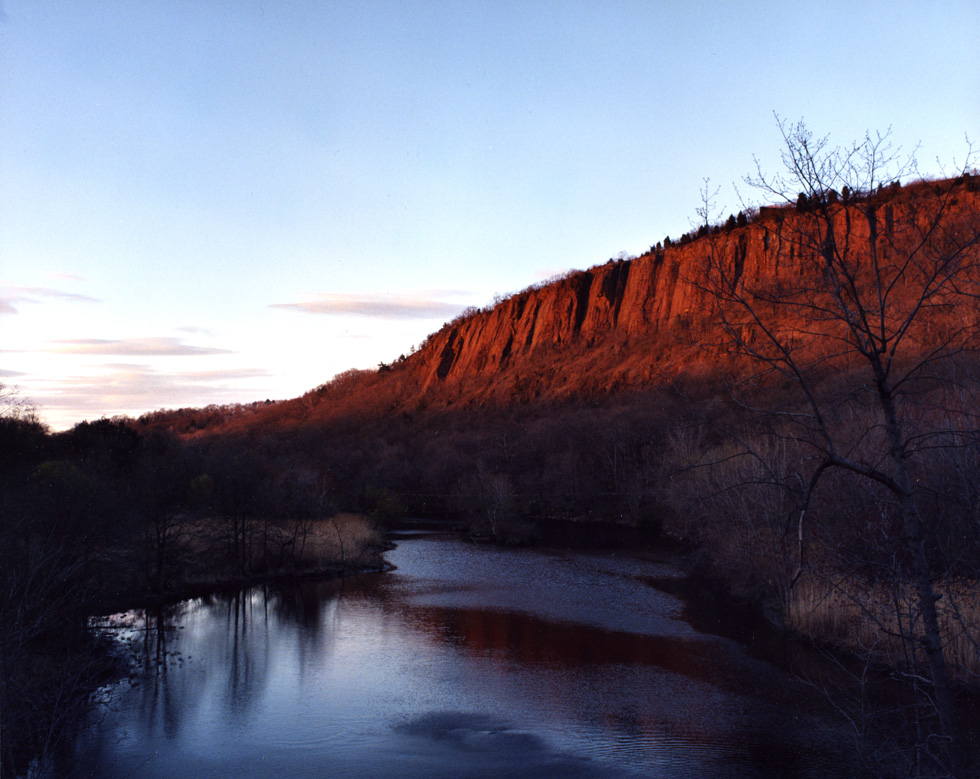 I live at the base of a mountain—400 steps from the edge of the river. Waterfowl share a waterfall not too far away. On a winter day we launch the ice floes from the river’s edge. They float with the current like mirrors. In the summer a canoe is offered there to city slickers and we stop paddling ours before we reach the covered bridge, gliding through the water lilies. The rushing sound of the waterfall is soft. It has rained and the water is overflowing heavily; a white cloud of droplets lassoes its center.
I live at the base of a mountain—400 steps from the edge of the river. Waterfowl share a waterfall not too far away. On a winter day we launch the ice floes from the river’s edge. They float with the current like mirrors. In the summer a canoe is offered there to city slickers and we stop paddling ours before we reach the covered bridge, gliding through the water lilies. The rushing sound of the waterfall is soft. It has rained and the water is overflowing heavily; a white cloud of droplets lassoes its center.
***
Winter has delivered a driving, freezing rain. The park is flooded. We calculate the depth of the alternative, snow. Earlier I watched a squirrel try to traverse the great lake which has formed. He jumps and leaps. Perhaps he expected to bounce but instead he lands in the deep cold water and does not emerge. I call out to my family from my vantage point at the dining room window. “I just saw a squirrel drown in the park.” I feel awful. When the water recedes we will find it and give it a proper burial. That night the flooded park freezes. The squirrel is now entombed in ice and the hockey players score goals over its stilled heart.
***
On my birthday, before my son turned two, I made a self-portrait photographing us with the mountain behind. I think perhaps there must have once been a Quinnipiac woman with her two year old son in this very spot with the red rock at her back in the sunset. The phone rings. It is my son’s father. An architect, he works in a converted factory building about a quarter mile away. “Did you see the color of the rock?” he asks.
***
I live in a city. From my attic studio I watch the rock become red then red orange. There goes my neighbor’s son. He is angry at his parents. He walks hurriedly toward the corner, crosses the street and heads into the park. He is running now towards the rock. By the time he reaches the center clearing—where concrete bleachers bear witness to a ghostly tennis match—he will be calmer. His cat has stopped at its territorial edge but he is followed by a neighbor’s dog—part gazelle—who runs with incredible speed as if she were propelled from a sling shot attached to the Soldier’s and Sailor’s monument. She is an arc, more aerodynamic and she would be airborne. I glance down to the bird feeders, noting that the golden and purple finches have finished off their thistle again.
***
Like Seurat’s Grande Jatte, College Woods is an island of diverse activity. It is filled each Sunday and Monday and Wednesday and all days with snapshots of life: A man on a bicycle trip rests on the grass while his clothes hang on a tree. There is a game of family reunion softball. There are dog walkers and kite flyers, basketball players, a man practices Tai Chi. A neighbor plants bulbs on a sloped hillside. A family bar-b-ques for a birthday party. Kids play on the swings and there’s always a newborn baby. Today there is lacrosse practice. Doctors are jogging: a brain surgeon, a psychiatrist carries a disposable camera. He will take a single photo during each day’s run.
***
I live in New Haven at the base of East Rock in a house built at the turn of the passing century. A small group converges on my corner. (It is the corner diagonally across the block from the artist’s studio which caught fire not too long ago and where respectful fireman rescued a life’s work of painting.) A car has flipped over. “How’d that happen?” I ask a familiar-looking man. He is a film actor. He likes the color of our house. When I see him again in the video store, I remind him: “You like the color of my house.”
***
Three oaks on my property skirt the view of East Rock. A decade ago they were stripped and ravaged, beheaded by a tornado that tore down our street toward a parkside rendezvous. It twirled and danced, dressed in an eerie green glow. Our roots have grown deep since then. I am now here in this college town longer than a bachelor’s degree, longer even than a Ph.D. A child has been conceived who writes poetry in a bedroom at the base of a mountain—400 steps from a river.